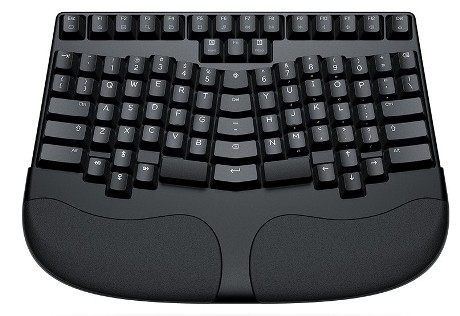
Keyboards: Ergonomic Tips for Healthy Typing
Warning: Computing Can Be Hazardous to Your Health
If you type 50 words per minute for an hour, you’ll have typed about 18,000 keystrokes. Keep that up all day, five days a week, and you’re giving your digits and wrists a hard-core workout. Typing’s repetitive movements can lead to muscle strain, pain, and weakness in the hands, arms and wrists – all of which are signs of carpal tunnel syndrome and other repetitive stress injuries (RSI). However, that’s not all that can be affected. A bad chair or poor posture can cause back and neck strain, and staring at your monitor for too long can cause headaches and eye strain.
Preventing Repetitive Stress injuries
Behavior Modification:
Make sure that your keyboard is lower than your elbows, and your wrists should be slightly higher than your fingers.
Don’t over-curl your fingers, drop or twist your wrists. This will put too much stress on your hands’ muscles and tendons. When you’re at the keyboard, keep your fingers just slightly curled and sit up straight.
Avoid tendonitis in the elbow (also known as tennis elbow) by making sure that your arms rest comfortably on the armrests of your chair, and that your elbows do not jut out at an awkward angle. Ideally, your elbows should bend at 90 degrees. The best chairs let you adjust the armrests to fit your body size.
Do you peck at the keyboard, using only a few fingers to do all the work? This can cause muscle strain. Learn to touch-type and you’ll reduce the pain and double your typing speed.
Take plenty of breaks (at least five minutes every hour).
Products to try:
Invest in a wrist-rest. This is a device that elevates your hands so that your wrists remain straight while typing, and is a great way to help prevent RSI. They range from simple foam pads to more sophisticated plastic shackles. Wrist-rests are sold at many computer stores.
Don’t want to spend the dough? Try a rolled up towel instead.
Dozens of keyboards claim to be ergonomic, and some of them actually deliver on that promise.
Three common incorrect practices and their symptoms:
Twisting: Long muscles are forced to stretch around the elbow, stressing muscles in the hands and arms. The symptoms include elbow inflammation, throbbing forearm, and the loss of dexterity in the ring and little fingers.
Over-curled fingers: Continuously flexed muscles that contract, which cause nerve compression in the wrist. Symptoms include pain in the wrist and forearm, and tingling or numbness in the fingers.
Dropped wrists: Tendons press against the nerves in the wrist, weakening the thumb, index, and ring fingers. Symptoms include numbness, tingling in the fingers at night, and swelling of the wrist and/or thumb.
Preventing Eye strain
Behavior modification:
Keep at least 20 inches between your eyes and the monitor, and adjust the monitor’s angle so that you don’t have to crane your neck to look at the screen. If you wear bifocals, adjust your monitor so that you’re looking down.
The light that you work by should be diffuse and overhead. A light source coming from the side, or worse, from behind, will make you squint; over time, you’ll develop headaches from eye strain.
It sound kinds of obvious, but have you adjusted the brightness and contrast on your screen?
This often overlooked solution can save you from squinting at a screen that is either too dim or too bright.
Contact lenses may cause eye strain in people who stare at a computer screen for hours on end. Try using your glasses instead. Photo-sensitive lenses soften the glare from the screen.
Products to try
Nothing is harder to look at than a bright monitor; it can cause headaches as well as eye strain. If your monitor’s screen is flickering, it’s causing strain on your eyes. A monitor that flickers usually has a low vertical refresh rate, a high dot pitch, or other problems. It’s probably time to get a new monitor.
See also:
- iGotOffer Encyclopedia: all information about Apple products, electronic devices, operating systems and apps.
Ergonomic Keyboard trulyergonomic.com






Facebook
Twitter
RSS